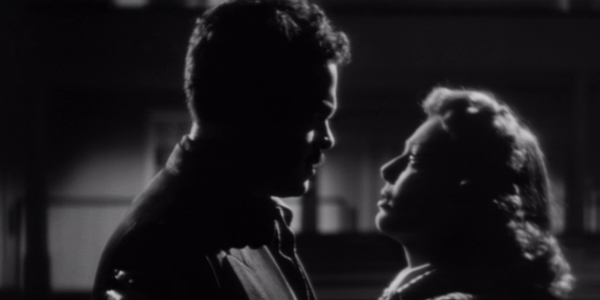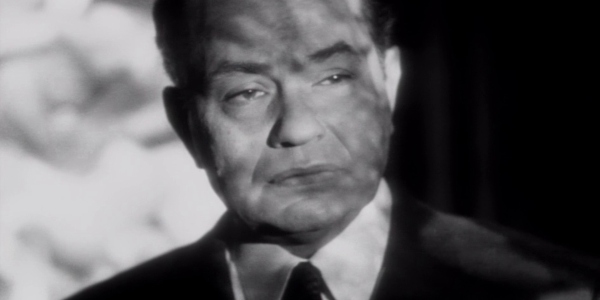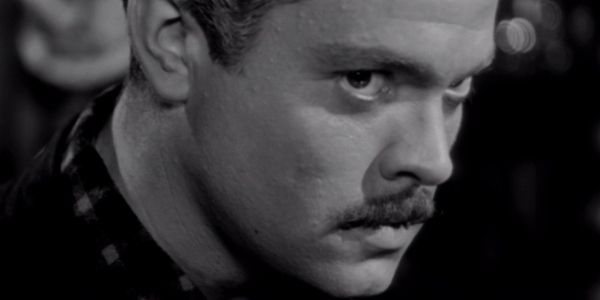On Wellesian Noir and THE STRANGER at 75

Freelance writer based in London. Pacino fanboy and trash connoisseur.
According to biographer Frank Brady, Orson Welles once said of his 1946 film noir The Stranger that “there is nothing of me in that picture”. It’s a statement that’s saturated with hyperbole of course, uttered by one of history’s greatest raconteurs — but the embellishment feels justifiable in context. The Stranger was, after all, made just a few years after The Magnificent Ambersons, Welles‘ sweeping, swirling masterpiece, which was famously mutilated at the hands of RKO, irrevocably cut down to the bone with all the subtlety of an axe murderer while Welles was working on another project for the studio, It’s All True, which was ultimately never finished.
The lacerations from that betrayal would surely still have been stinging when Welles agreed to work on The Stranger under stringent supervision, in order to prove that he could deliver a film on time and under budget. If he was going to pick up the pieces of his Hollywood career, Welles would have to surrender to the will of the studio higher-ups — in this case Sam Spiegel of International Pictures. And surrender he did, signing a contract that would see him owe the studio financial compensation if he didn’t fulfill his obligations, and conceding control of the editing room to “supercutter” Ernest Nims, who would go on to mangle Touch of Evil, and whom Welles would go on to describe as his “nemesis”. A far cry from the carte blanche that the wunderkind had been given when he burst onto the scene with Citizen Kane.

It’s a testament to Welles‘ peerless, indelible vision then, that just as The Magnificent Ambersons remains as stunning as it is even in its brutally truncated form, The Stranger still endures as an indispensable entry in a coruscating filmography, much richer than its minor reputation would suggest. Even while tethered by studio limitations, Welles brings enough formal firepower to elevate what could’ve been a conventional commercial thriller onto the level of his more conspicuously idiosyncratic, totemic noirs, complicating simplistic material with every weapon in the arsenal: stealthy long takes, crane shots, low angles, nightmarish shadow plays, and intricate set-pieces. Predictably, what the towering auteur considered to be his weakest work is still infinitely more fascinating and distinctive than the strongest efforts of most other directors.
Moorehead vs. Robinson
Evidence of studio imposition is visible from the get-go, as the film hurtles through its lean introductory sequences with ruthless efficiency (Welles‘ rewrites of Anthony Veiller‘s script would’ve heightened the ominous atmosphere and expounded upon character details, but were ultimately slashed by Spiegel). We open on the emancipation of incarcerated Nazi war criminal Konrad Meinike (Konstantin Shayne), facilitated by UN agent Mr. Wilson (played by Edward G. Robinson, although Welles had wanted to cast Agnes Moorehead), who hopes that Meinike will lead him to his real target: the elusive, clock-obsessed Franz Kindler (Orson Welles), one of the Nazi party’s foremost thinkers, and one of the primary architects of the Holocaust, who now operates under a new identity. And indeed, Meinike manages to track the charismatic Kindler down to the rural town of Harper, Connecticut (shaking the tailing Wilson along the way), where the former mastermind, wielding his supreme command of the English language and the American accent, has embedded himself into the heart of the community as local teacher Charles Rankin, and is about to marry Mary Longstreet (a wide-eyed Loretta Young), the daughter of a Supreme Court Justice.
It’s hard not to wonder what Welles‘ unfettered take on The Stranger would’ve looked like, and harder still not to yearn for that version, although none of the studio’s meddling sounds as egregious as the eviscerations that would be wreaked upon The Lady from Shanghai and Touch of Evil. The version that we got remains remarkably Wellesian, oozing with inky darkness, which shrouds innocent and guilty faces alike, and obfuscates the latent fascism bubbling beneath the pristine crust of America.
Indeed, perhaps the most interesting change that was foisted upon Welles wasn’t in scripting or aesthetic, but in personnel — the casting of Robinson over Moorehead in the Wilson role provides a lot of ideas over which to stew. There’s something captivating about the prospect of Moorehead playing detective — the obsessive tough lady smoking her pipe, hanging with the local boys, zeroing in on Rankin with that steely gaze, aggressively asserting herself over her male colleagues. In particular, Wilson’s pressurisation and exploitation of the emotionally vulnerable Mary would no doubt take on an entirely different, maybe thornier moral context — would the process of extracting information by inflicting trauma feel even crueler, even more, devoid of compassion, if Wilson were a woman?
It’s a shame that Moorehead never got to star as a gumshoe in her own female-led noir — a lamentably thin subcategory of the genre under which there are far too few significant entries — because that inimitable aura of authority that she could transmit seemed to scream out for such a role. Watching Ella Raines bring so much depth to her sleuthing in Robert Siodmak‘s sublime The Phantom Lady gets you thinking about all the other great actresses of that era who could’ve shone as hardboiled private eyes, straddling nebulous ethical lines, probing the putrescent cores of masculine institutions. Moorehead would surely be chief amongst those candidates, alongside the likes of Joan Crawford, Marlene Dietrich, and Barbara Stanwyck.

Still, it’s undeniable that Robinson‘s casting in The Stranger brings its own added dimension. Born Emanuel Goldenberg, a Romanian Jew, Robinson emigrated aged 10 with his family from their home country to the United States after suffering anti-semitic persecution, and was, throughout his entire life, a vociferous anti-fascist. That background makes it inherently compelling to watch Robinson‘s Wilson strategise against Welles‘ camouflaged Kindler, laying traps for the Nazi mastermind who finds it all too easy to hide behind the white picket fences. A victim of poisonous ideology playing a man fixated upon eradicating that same poison from the heart of the nation to which he fled, manipulating, scarring, and imperilling his fellow countrymen in the process — there are layers and fathoms to this drama that exist beyond the surface of the text.
In Plain Sight
In the end, it’s actually Welles himself who takes The Stranger to another level with his serpentine performance. All three of his noirs confirm Welles not only as one of cinema’s greatest stylists, but also as one of the most uniquely charismatic presences to ever grace the screen, seemingly generating his own gravitational field as the bumbling everyman, the slimeball cop, or the chameleonic Nazi, while everybody else simply orbits around him. As the diabolical Kindler, Welles luxuriates in the delicious doubleness of the fugitive fascist — having so meticulously expunged all traces of his history and fabricated the Rankin masquerade, Kindler can’t help but betray himself with his febrility when his motherland is mentioned, using the dinner table as a podium as he rattles off a logorrheic, poetic stream of thoughts on the nature of “the German,” who “still follows his warrior gods, marching to Wagnerian strings, his eyes still fixed upon the fiery sword of Siegfried,” and for whom “the Messiah is not the Prince of Peace. No, he’s another Barbarossa — another Hitler.”
Pretty obvious that this guy’s a Nazi, right? Welles‘ indulgent facial expressions and the ardent undulations of his delivery make it all the more incredible that nobody except Wilson seems to pick up on the alarming overtones of the lecture, even when Kindler goes as far as to declare that “Marx wasn’t a German, Marx was a Jew.” There’s certainly an argument to be made that Welles stretches believability beyond breaking point, that the film becomes too silly in its depiction of an increasingly unhinged fascist flying totally under the radar for its ideas to be taken seriously.

But that’s exactly the point, isn’t it? Kindler’s penetration into self-satisfied Harper society, like Uncle Charlie’s integration into Santa Rosa in Alfred Hitchc*ck‘s Shadow of a Doubt, is so smooth and emphatic because nobody can even begin to imagine that good old America, with its virtuous values, could ever possibly harbour any sort of evil, which makes for exactly the sort of incubator in which evil can gestate undisturbed, and perhaps even disseminate — Kindler’s choice of occupation gives him intimate access to malleable young minds, presenting a particularly insidious threat. Kindler has chosen Harper as his base of operations partly because the job of repairing the town church’s clock mechanism satiates his temporal mania, but primarily because everything about the place is emblematic of America’s susceptibility to fascist infiltration. When Mary still refuses to condemn her husband, even after he admits to killing both Meinike and Mary’s beloved dog, Red (who’d been digging at Meinike’s grave in the woods), and even after Wilson shows her harrowing footage of Nazi atrocities (there’s something especially haunting about these images flickering across Robinson’s face), you realise it would take something truly outrageous for Kindler to be exposed for what he really is — maybe a Sieg Heil would do the trick, or maybe two.
Wellesian Irony
In the end, International Pictures reneged on their promise to Welles of a four-picture deal, despite the punctual completion and financial success of The Stranger. The irony couldn’t be more bitter — Welles‘ one real triumph at the box office, in a career defined by commercial rejection, was rewarded only with more treachery. No wonder Welles dismissed and disowned the film — it would take a man of preternatural, even inhuman equanimity to bury that resentment.
The Stranger doesn’t deserve that dismissal, though. Dwarfed though it may be by the numerous aesthetic touchstones that dominate Welles‘ oeuvre, it towers over the plainer, flatter thrillers with which it’s so often been unfairly bundled over the years. And if you still can’t take it seriously because you find Kindler’s ability to remain undetected despite his fascist salvos implausible, you might want to take another look at the America of today.
Does content like this matter to you?
Become a Member and support film journalism. Unlock access to all of Film Inquiry`s great articles. Join a community of like-minded readers who are passionate about cinema - get access to our private members Network, give back to independent filmmakers, and more.













